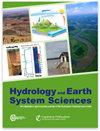Changes in Mediterranean flood processes and seasonality
IF 5.8
1区 地球科学
Q1 GEOSCIENCES, MULTIDISCIPLINARY
引用次数: 1
Abstract
Abstract. Floods are a major natural hazard in the Mediterranean region, causing deaths and extensive damages. Recent studies have shown that intense rainfall events are becoming more extreme in this region but, paradoxically, without leading to an increase in the severity of floods. Consequently, it is important to understand how flood events are changing to explain this absence of trends in flood magnitude despite increased rainfall extremes. A database of 98 stations in southern France with an average record of 50 years of daily river discharge data between 1959 and 2021 was considered, together with a high-resolution reanalysis product providing precipitation and simulated soil moisture and a classification of weather patterns associated with rainfall events over France. Flood events, corresponding to an average occurrence of 1 event per year (5317 events in total), were extracted and classified into excess-rainfall, short-rainfall, and long-rainfall event types. Several flood event characteristics have been also analyzed: flood event durations, base flow contribution to floods, runoff coefficient, total and maximum event rainfall, and antecedent soil moisture. The evolution through time of these flood event characteristics and seasonality was analyzed. Results indicated that, in most basins, floods tend to occur earlier during the year, the mean flood date being, on average, advanced by 1 month between 1959–1990 and 1991–2021. This seasonal shift could be attributed to the increased frequency of southern-circulation weather types during spring and summer. An increase in total and extreme-event precipitation has been observed, associated with a decrease of antecedent soil moisture before rainfall events. The majority of flood events are associated with excess rainfall on saturated soils, but their relative proportion is decreasing over time, notably in spring, with a concurrent increased frequency of short rain floods. For most basins there is a positive correlation between antecedent soil moisture and flood event runoff coefficients that is remaining stable over time, with dryer soils producing less runoff and a lower contribution of base flow to floods. In a context of increasing aridity, this relationship is the likely cause of the absence of trends in flood magnitudes observed in this region and the change of event types. These changes in flood characteristics are quite homogeneous over the domain studied, suggesting that they are rather linked to the evolution of the regional climate than to catchment characteristics. Consequently, this study shows that even in the absence of trends, flood properties may change over time, and these changes need to be accounted for when analyzing the long-term evolution of flood hazards.地中海洪水过程和季节性的变化
摘要洪水是地中海地区的一项重大自然灾害,造成死亡和广泛破坏。最近的研究表明,该地区的强降雨正变得越来越极端,但矛盾的是,这并没有导致洪水的严重程度增加。因此,了解洪水事件是如何变化的,以解释尽管极端降雨增加,洪水强度却没有趋势,这一点很重要。考虑了法国南部98个站点的数据库,其中包含1959年至2021年间50年每日河流流量的平均记录,以及提供降水和模拟土壤湿度的高分辨率再分析产品,以及与法国降雨事件相关的天气模式分类。提取平均每年发生1次(共5317次)的洪水事件,并将其分为多雨、短雨和长雨事件类型。还分析了洪水事件的几个特征:洪水事件持续时间、基流对洪水的贡献、径流系数、总降雨量和最大降雨量以及前土壤湿度。分析了这些洪水事件特征和季节性的时间演变。结果表明:1959-1990年和1991 - 2021年,大部分流域的洪水发生时间都有提前的趋势,平均洪水日期平均提前1个月;这种季节变化可归因于春季和夏季南环流天气类型的频率增加。观测到总降水和极端事件降水的增加,这与降雨前土壤水分的减少有关。大多数洪水事件与饱和土壤上的过量降雨有关,但其相对比例随着时间的推移而减少,特别是在春季,与此同时,短雨洪水的频率增加。对于大多数流域,前期土壤湿度与洪水事件径流系数之间存在正相关关系,且随着时间的推移保持稳定,干燥土壤产生的径流较少,基流对洪水的贡献也较低。在日益干旱的背景下,这种关系很可能是该地区观测到的洪水量级缺乏趋势和事件类型变化的原因。这些洪水特征的变化在研究区域内是相当均匀的,这表明它们与区域气候的演变有关,而不是与流域特征有关。因此,本研究表明,即使在没有趋势的情况下,洪水性质也可能随着时间的推移而变化,在分析洪水灾害的长期演变时需要考虑这些变化。
本文章由计算机程序翻译,如有差异,请以英文原文为准。
求助全文
约1分钟内获得全文
求助全文
来源期刊

Hydrology and Earth System Sciences
地学-地球科学综合
CiteScore
10.10
自引率
7.90%
发文量
273
审稿时长
15 months
期刊介绍:
Hydrology and Earth System Sciences (HESS) is a not-for-profit international two-stage open-access journal for the publication of original research in hydrology. HESS encourages and supports fundamental and applied research that advances the understanding of hydrological systems, their role in providing water for ecosystems and society, and the role of the water cycle in the functioning of the Earth system. A multi-disciplinary approach is encouraged that broadens the hydrological perspective and the advancement of hydrological science through integration with other cognate sciences and cross-fertilization across disciplinary boundaries.
 求助内容:
求助内容: 应助结果提醒方式:
应助结果提醒方式:


